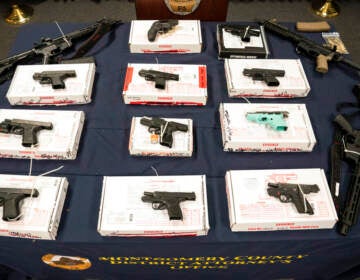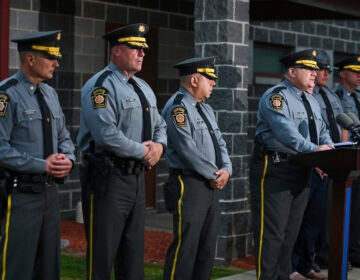Facts don’t line up in the police shooting of Anthony Allegrini Jr., independent investigator says
Law enforcement officials still haven’t released findings about the Pa. state trooper killing of 18-year-old Anthony Allegrini Jr. on June 4.

Anthony Allegrini Sr. and Jennifer Allegrini mourn their son, Anthony Allegrini Jr., in their Delaware County home in the days after his death. (Sammy Caiola /WHYY News)
Terence Jones wants answers about the shooting of Anthony Allegrini Jr. — the 18-year-old killed by a Pennsylvania state trooper during an illegal car racing meetup on I-95 in early June.
The former Philadelphia Police Department officer has spent the last 15 years pushing for cops who unjustly harm civilians to be held accountable. He’s conducted independent investigations into the police shootings of Freddie Gray in Baltimore, Radazz Hearns in Trenton, and T.J. Sidiero in Philadelphia. Jones claims his advocacy has contributed to the arrest or firing of 13 police officers.
Now he’s looking into Allegrini Jr.’s death. Jones has filed a complaint with the state police’s Bureau of Integrity and Professional Standards Internal Affairs Division. He’s calling for an internal investigation of the two troopers involved and an immediate release of their names.
“The troopers have a strong motive to be dishonest and are not credible victims or witnesses,” the complaint reads. “They are depending on the Pennsylvania State Police to close ranks and turn a blind eye and deaf ear to their unlawful behavior.”
The Pa. State Police are already investigating the two troopers internally. The trooper who discharged his weapon is out due to injuries sustained the night of the incident but, according to the department, has not been cleared for full duty. The other trooper who was involved, but did not fire, has returned to work.
The Philadelphia District Attorney’s Office is leading a criminal investigation into the incident. Neither department has provided a timeline on when those investigations will conclude.
Allegrini Jr.’s family said they’ve gotten no updates about their case. His cousin posted a YouTube video calling on investigators to be more transparent.
In June, his parents were trying to figure out how their son’s life ended so suddenly.
Days after the funeral, their living room was full of flowers and photos showing Allegrini Jr. smiling and laughing with his family and friends.

“We just want the truth,” Anthony Allegrini Sr. said. “We’re not trained professionals in this, we’re just mom and dad. So we don’t know. But whatever’s left of this, we have to make it right.”
Neither the DA’s Office nor Pa. State Police would release the names of the officers involved, or an update on the findings.
“Normally what happens is when the DA’s Office clears the trooper or where charges are filed criminally against an involved member of law enforcement, their names are normally released then,” Pa. State Police spokesperson Adam Reed said. “There’s no hard and fast rule.”
What really happened?
Captain Gerard McShea said at a press conference the day after the shooting that Allegrini Jr. was driving his Audi toward the two troopers, and “failed to yield.” McShea said both officers were injured due to being struck by the vehicle, and that one trooper fired a shot into the front windshield, killing the teen.
Department policy states that officers “shall not discharge a firearm at a moving motor vehicle” unless the vehicle, driver, or passenger “poses an imminent threat of death or serious bodily injury.”
Jones said there’s no way that the risk to the trooper’s life was great enough to justify a fatal shot.
“They had plenty of time to not put themselves in imminent danger,” he said. “Why would you put yourself in front of a 4,000-something-pound Audi S4 vehicle where you could be hit?”
Pa. State Police leaders have a history of protecting officers who use excessive force, Jones said. He cited the case of Jay Splain — a trooper who has continually been cleared despite killing four people while on duty, according to reporting from the New York Times.
Jones was himself cleared for a fatal shooting of a pedestrian in 1998, which happened during an altercation with a civilian who tried to take his gun while he was off-duty, he said.
He said law enforcement agencies must thoroughly investigate officers and “stop empowering them to believe that they are above the law.”’
“If most officers are good, only a few are bad, why can’t the good ones hold the bad ones accountable?” he said.
‘They should have tried to save him’
Pa. State Police are not issued body-worn cameras, according to McShea. This week, the department announced that 43 troopers in south-central Pennsylvania will begin wearing them as part of a pilot program.
Rashawn Ray, a senior fellow at a public policy think tank called the Brookings Institution and vice president at the American Institutes for Research, said the fact that the department doesn’t have this technology across the board is “a big concern.”
“In 2023 these are things that should definitely be in place no matter what,” he said.
Jones, and the Allegrini family have been relying on bystander video to try to put together an order of events. Some videos show what appears to be Allegrini Jr’s body lying on the interstate, wounded but still moving. In one, a trooper points a firearm at the person filming and tells them to stop.
Other footage shows passersby yelling at the troopers to render medical aid to the victim.
“It’s just tragic, I believe they should have rendered aid,” said Jennifer Allegrini, mother of Anthony Allegrini Jr. “They should have tried to save him.”
At the press conference, McShea said he could not comment on whether or not the troopers provided treatment to Allegrini Jr. following the shooting, due to the ongoing investigation.

A push for consequences
Jones has been examining video footage of the shooting provided by the family. His complaint argues that the troopers didn’t have a valid reason to approach Allegrini Jr.’s car in the first place, and that troopers didn’t have legal cause to shoot him. Jones also argues the troopers were not struck or injured during the incident and that they should have administered first aid after the shooting.
He also said the trooper who pointed the gun at the civilian recording video should also be held accountable.
“All that the motorist was doing was exercising their legal right to record him with the cell phone, they were not interfering with anything,” Jones said.
Jones’ work is part of a national push for more police reform and accountability that has gained traction since George Floyd’s murder, experts say.
Rashawn Ray at The Brookings Institution says law enforcement can reduce the risk of officers breaking protocol by looking at psychological evaluations during the hiring process, creating community oversight boards where members have votes on internal police investigations, and carrying liability insurance.
“Insurance companies can play a role in getting those problematic officers off the street, because they become uninsurable — just like people who keep breaking their car,” he said.
Philadelphia Police Commissioner Danielle Outlaw told WHYY News that it’s difficult for her to discipline officers, because the decision about what the consequences should be ultimately lies with an arbitration panel made up of officers and representatives of the Fraternal Order of Police union.
Previously, if someone had a violation it could only be considered part of their record for a year, she said. She extended that timeline for certain violations, so they can be considered for the duration of employment.
“I found that fixing the system itself, of accountability, to make sure that when we do get to termination it’s airtight — I think it’s helpful,” she said.
Both the Philadelphia Police Department and the Pa. State Police use an Early Intervention System —an electronic database that can track use-of-force reports, citizen complaints and other performance indicators, according to the U.S. Department of Justice.
A 2021 study from the University of Chicago found that while these systems have “the potential to prevent adverse policing outcomes,” there’s little evidence of the actual impacts of the types of EIS programs that police departments have implemented.
Some police departments, including PPD, have also instituted the Active Bystandership in Law Enforcement program, which trains officers to prevent police misconduct among their peers by looking for warning signs in the field.

Get daily updates from WHYY News!
WHYY is your source for fact-based, in-depth journalism and information. As a nonprofit organization, we rely on financial support from readers like you. Please give today.







